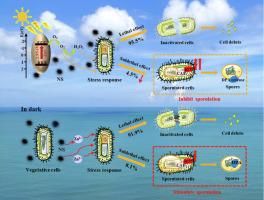Environment International ( IF 11.8 ) Pub Date : 2022-08-10 , DOI: 10.1016/j.envint.2022.107460 Wanjun Wang 1 , Yan Liu 1 , Guiying Li 1 , Zhenni Liu 1 , Po Keung Wong 1 , Taicheng An 1

|
Unveiling the mechanisms of bacterial sporulation at natural mineral interfaces is crucial to fully understand the interactions of mineral with microorganism in aquatic environment. In this study, the bacterial sporulation mechanisms of Bacillus subtilis (B. subtilis) at natural sphalerite (NS) interface with and without light irradiation were systematically investigated for the first time. Under dark condition, NS was found to inactivate vegetative cells of B. subtilis and promote their sporulation simultaneously. The released Zn2+ from NS was mainly responsible for the bacterial inactivation and sporulation. With light irradiation, the photocatalytic effect from NS could increase the bacterial inactivation efficiency, while the bacterial sporulation efficiency was decreased from 8.1 % to 4.5 %. The photo-generated H2O2 and  O2– played the major roles in enhancing bacterial inactivation and suppressing bacterial sporulation process. The intracellular synthesis of dipicolinic acid (DPA) as biomarker for sporulation was promoted by NS in dark, which was suppressed by the photocatalytic effect of NS with light irradiation. The transformation process from vegetative cells to spores was monitored by both 3D-fluerecence EEM and SEM observations. Compared with the NS alone system, the NS/light combined system induced higher level of intracellular ROSs, up-regulated antioxidant enzyme activity and decreased cell metabolism activity, which eventually led to enhanced inactivation of vegetative cells and suppressed bacterial sporulation. These results not only provide in-depth understanding about bacterial sporulation as a new mode of sub-lethal stress response at NS interface, but also shed lights on putting forward suitable strategies for controlling spore-producing bacteria by suppressing their sporulation during water disinfection.
O2– played the major roles in enhancing bacterial inactivation and suppressing bacterial sporulation process. The intracellular synthesis of dipicolinic acid (DPA) as biomarker for sporulation was promoted by NS in dark, which was suppressed by the photocatalytic effect of NS with light irradiation. The transformation process from vegetative cells to spores was monitored by both 3D-fluerecence EEM and SEM observations. Compared with the NS alone system, the NS/light combined system induced higher level of intracellular ROSs, up-regulated antioxidant enzyme activity and decreased cell metabolism activity, which eventually led to enhanced inactivation of vegetative cells and suppressed bacterial sporulation. These results not only provide in-depth understanding about bacterial sporulation as a new mode of sub-lethal stress response at NS interface, but also shed lights on putting forward suitable strategies for controlling spore-producing bacteria by suppressing their sporulation during water disinfection.
中文翻译:

光照射和无光照射下天然闪锌矿界面细菌孢子形成的机制见解:光催化对细菌孢子形成的抑制作用
揭示天然矿物界面细菌孢子形成的机制对于充分了解水生环境中矿物质与微生物的相互作用至关重要。本研究首次系统研究了枯草芽孢杆菌(B. subtilis )在光照射和未照射的天然闪锌矿(NS)界面处的细菌孢子形成机制。在黑暗条件下,NS 可以使枯草芽孢杆菌的营养细胞失活,同时促进其孢子形成。NS释放的Zn 2+主要负责细菌灭活和孢子形成。在光照射下,NS的光催化作用可以提高细菌灭活效率,而细菌孢子形成效率从8.1%下降到4.5%。光生H 2 O 2和 O 2 –在增强细菌灭活和抑制细菌孢子形成过程中发挥着主要作用。NS 在黑暗中促进细胞内合成吡啶二羧酸 (DPA) 作为孢子形成的生物标志物,而在光照射下 NS 的光催化作用则抑制这种合成。通过 3D 荧光 EEM 和 SEM 观察监测从营养细胞到孢子的转化过程。与单独的NS系统相比,NS/光联合系统诱导细胞内ROS水平升高,抗氧化酶活性上调,细胞代谢活性降低,最终导致营养细胞失活增强,抑制细菌孢子形成。这些结果不仅提供了对细菌孢子形成作为NS界面亚致死应激反应新模式的深入了解,而且有助于提出合适的策略,通过在水消毒过程中抑制产孢细菌的孢子形成来控制产孢细菌。
O 2 –在增强细菌灭活和抑制细菌孢子形成过程中发挥着主要作用。NS 在黑暗中促进细胞内合成吡啶二羧酸 (DPA) 作为孢子形成的生物标志物,而在光照射下 NS 的光催化作用则抑制这种合成。通过 3D 荧光 EEM 和 SEM 观察监测从营养细胞到孢子的转化过程。与单独的NS系统相比,NS/光联合系统诱导细胞内ROS水平升高,抗氧化酶活性上调,细胞代谢活性降低,最终导致营养细胞失活增强,抑制细菌孢子形成。这些结果不仅提供了对细菌孢子形成作为NS界面亚致死应激反应新模式的深入了解,而且有助于提出合适的策略,通过在水消毒过程中抑制产孢细菌的孢子形成来控制产孢细菌。


























 京公网安备 11010802027423号
京公网安备 11010802027423号